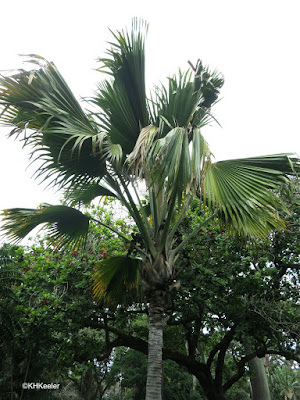I recently took an off-season holiday in Honolulu, Hawaii. Inevitably, my steps took me to botanic gardens. One of Honolulu’s highlights is Foster Botanical Garden. In the heart of modern Honolulu, it was once part of the estate of the Hawaiian Queen Kalama (1817-1870), was planted with tropical trees that might become cash crops on the Islands by Dr. William Hildebrand (1821-1886) in the middle 1800s and ultimately donated to the City and County of Honolulu in 1930 by Mary Robinson Foster (1844-1930), of royal Hawaiian descent and widow of sea captain Thomas Foster (1835-1889).
Many of the trees are huge, for example:
Many of the trees are huge, for example:
Queensland kauri, Aganthis robusta, an Australian tree in the Auricariaceae, a family of Southern Hemisphere conifers. They can grow 150 feet tall and 24 feet wide and produce lots of desirable wood.
or this, the blue marble tree (Elaeocarpus persicaefolius), from New Caldonia in the Pacific, with its own family, Elaeocarpaceae)
It drops these cool fruits
The fruits I saw were small for marbles--slightly smaller than a dime--but the Foster visitor center had some that could certainly have been used in a game of marbles (except they're not quite round.)
And there were all kinds of palms (palm family, Arecaceae)
Cuban royal palms Roystonea regia from the Caribbean.
It drops these cool fruits
The fruits I saw were small for marbles--slightly smaller than a dime--but the Foster visitor center had some that could certainly have been used in a game of marbles (except they're not quite round.)
And there were all kinds of palms (palm family, Arecaceae)
Cuban royal palms Roystonea regia from the Caribbean.
And this talipot palm, Corypha umbraculifera , from India.
Not only does it take a spectacular photograph, it is monocarpic, so, like salmon and century plants, it flowers once in a lifetime and dies. This one had lived to about 25. The photo below shows the leaves that have been cannibalized (if you can use that word on a plant) to feed the seeds. It flowered a full year ago, initiating death, so, like many big monocarpic plants, it does an extended, dramatic death scene.
Not only does it take a spectacular photograph, it is monocarpic, so, like salmon and century plants, it flowers once in a lifetime and dies. This one had lived to about 25. The photo below shows the leaves that have been cannibalized (if you can use that word on a plant) to feed the seeds. It flowered a full year ago, initiating death, so, like many big monocarpic plants, it does an extended, dramatic death scene.
Flowering in a more conventional way (many times in a lifetime, polycarpic) was the pink trumpet tree Tabebuia heterophylla (catalpa family, Bignoniaceae) of the American tropics.
Here are the flowers, closer up
There were so many trees and shrubs and herbs to admire, but let me particularly point out two treasures
There were so many trees and shrubs and herbs to admire, but let me particularly point out two treasures
First, the Bodhi Tree. This fig tree is not just another big beautiful fig tree, genus Ficus (fig family Moraceae), not just Ficus religiosa called the sacred fig, bo tree or bodhi tree, but a cutting from the tree in Sri Lanka that was grown from a cutting of the actual bodhi tree under which Siddhartha, later the Buddha, sat when he became enlightened. It was given to Mary Foster in 1913. It is surely one of the most famous plants in the world.
 |
| coco de mer, double coconut tree |
And the double coconut, also called coco de mer, Lodioicea maldivica, the palm that makes the world's largest seed--up to 35 pounds. Native to the Seychelles in the Indian Ocean, I had never seen one. (more about it link)
AND Foster Botanical Garden had double coconut seeds. The plants are dioecious, the one at Forster is female. In 2011 they got pollen from a male plant at the Singapore Botanic Garden to pollinate it. (Good story: botanists waiting until both plants were flowering and then quickly gathering and PRIORITY shipping a vial of pollen across the Pacific.) Pollination worked and in 2017 several fruits ripened and fell. They have planted the seeds and are watching for a leaf.
It is a small garden full of botanical treats. If you are in Honolulu, go see these plants!
The Garden's excellent signs helped me greatly. I especially wanted to thank docent Lana Brodziak who led a free public tour that was a delight. She set me straight on plants I had confused and sent me in pursuit of some really good stories.
 |
| Lawn at Foster Botanical Garden |
Comments and corrections welcome.











The pink trumpet tree Tabebuia heterophylla) belongs to the family Bignoniaceae, not Fabaceae.
ReplyDeleteYikes! You are right! I'll fix it!
ReplyDelete